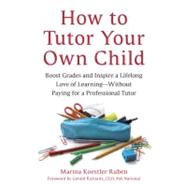
| Acknowledgments | p. vii |
| Foreword | p. ix |
| Introduction: The Best Tutors I Never Knew I Had | p. 1 |
| Starting Out: Why Tutor? | p. 5 |
| Getting Down To It: The Basics | p. 14 |
| Mindset over Matter: Thinking Like a Professional Tutor | p. 44 |
| Feasts, Field Trips, and Froebel: The Creative Parent-Tutor | p. 70 |
| Put It on the Wall: Living the Parent-Tutor Lifestyle | p. 92 |
| iDon't Think iKnow Where My Homework Is: Helping Kids Connect and Organize for the Twenty-First Century | p. 110 |
| How Much for an A? The Ethical Parent-Tutor | p. 139 |
| Points of Contact: Parent-Tutored Teens | p. 162 |
| Resources | p. 180 |
| Notes | p. 188 |
| About the Author | p. 191 |
| Index | p. 192 |
| Table of Contents provided by Ingram. All Rights Reserved. |
The New copy of this book will include any supplemental materials advertised. Please check the title of the book to determine if it should include any access cards, study guides, lab manuals, CDs, etc.
The Used, Rental and eBook copies of this book are not guaranteed to include any supplemental materials. Typically, only the book itself is included. This is true even if the title states it includes any access cards, study guides, lab manuals, CDs, etc.